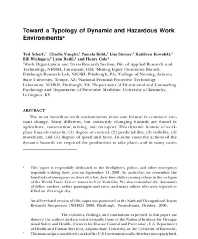Mining Publication: Toward a Typology of Dynamic and Hazardous Work Environments
Original creation date: December 2001
The most hazardous work environments share one feature in common: constant change. Many different, but constantly changing hazards are found in agriculture, construction, mining, and transport. This dynamic feature of workplace hazards varies by: (1) degree of control, (2) predictability, (3) visibility, (4) movement, and (5) degree of speed and force. In some cases the actions of the dynamic hazards are required for production to take place, and in many cases, several different hazards may overlap and interact. Finally, whether intentional or unintentional, some dynamic hazards are human generated. These are some of the features that distinguish dynamic and hazardous work environments across a variety of industries. The authors propose a preliminary typology of dynamic and hazardous work environments, along with a schema to systematically observe the dynamic characteristics of these hazards. The implications of this typology are considered with respect to worker training, hazard awareness, and safe work practices. For example, the implementation of the Hierarchy of Control is shown to require active worker involvement at every level in the hierarchy, except where an environmental hazard has been completely eliminated.
Authors: T Scharf, C Vaught, P Kidd, LJ Steiner, KM Kowalski, WJ Wiehagen, LL Rethi, HP Cole
Peer Reviewed Journal Article - December 2001
NIOSHTIC2 Number: 20021061
Hum Ecol Risk Assess 2001 Dec 7(7):1827-1841
See Also
- A Case Study of Roof Bolting Tasks to Identify Cumulative Trauma Exposure
- Job Design: An Effective Strategy for Reducing Back Injuries
- Job Training Analysis: A Process for Quickly Developing a Roadmap for Teaching and Evaluating Job Skills
- Practical Risk Assessment Guidelines for Identifying, Assessing, and Mitigating Stored Energy Hazards in Underground Coal Mines During and After a Mine Emergency
- Repeatability of a Checklist for Evaluation Cab Design Characteristics of Heavy Mobile Equipment
- SPONCOM - A Computer Program for the Prediction of the Spontaneous Combustion Potential of an Underground Coal Mine
- SponCom - Spontaneous Combustion Assessment Software - 2.0
- Task Analysis
- Task-Specific Postures in Low-Seam Underground Coal Mining
- Technology News 545 - NIOSH Updates Spontaneous Combustion Assessment Software
- Content source: National Institute for Occupational Safety and Health, Mining Program


 ShareCompartir
ShareCompartir
